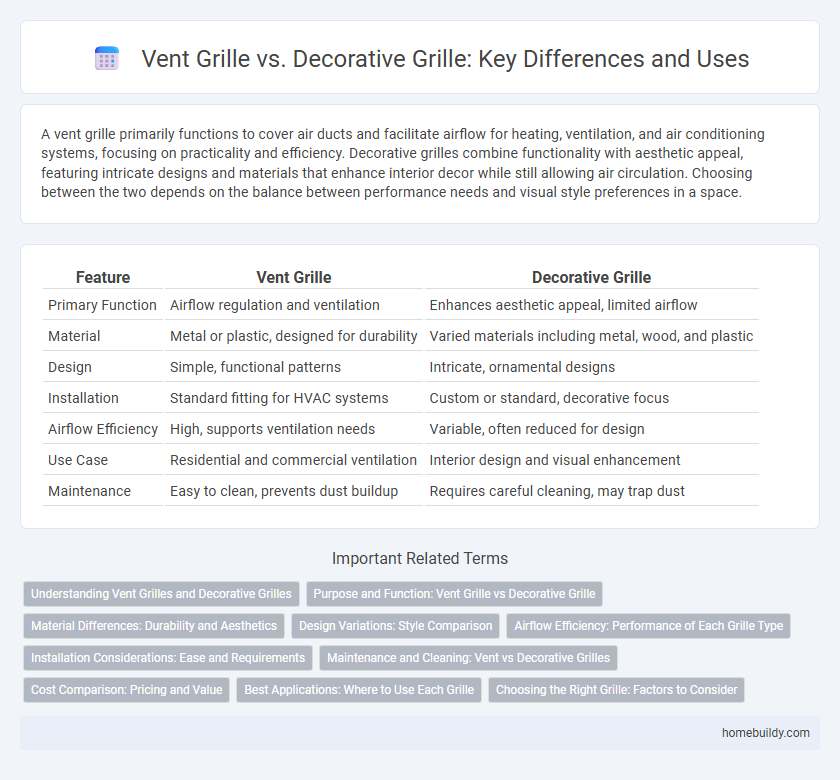A vent grille primarily functions to cover air ducts and facilitate airflow for heating, ventilation, and air conditioning systems, focusing on practicality and efficiency. Decorative grilles combine functionality with aesthetic appeal, featuring intricate designs and materials that enhance interior decor while still allowing air circulation. Choosing between the two depends on the balance between performance needs and visual style preferences in a space.
Table of Comparison
| Feature | Vent Grille | Decorative Grille |
|---|---|---|
| Primary Function | Airflow regulation and ventilation | Enhances aesthetic appeal, limited airflow |
| Material | Metal or plastic, designed for durability | Varied materials including metal, wood, and plastic |
| Design | Simple, functional patterns | Intricate, ornamental designs |
| Installation | Standard fitting for HVAC systems | Custom or standard, decorative focus |
| Airflow Efficiency | High, supports ventilation needs | Variable, often reduced for design |
| Use Case | Residential and commercial ventilation | Interior design and visual enhancement |
| Maintenance | Easy to clean, prevents dust buildup | Requires careful cleaning, may trap dust |
Understanding Vent Grilles and Decorative Grilles
Vent grilles primarily facilitate airflow within HVAC systems, ensuring efficient ventilation and temperature control by regulating air passage. Decorative grilles serve an aesthetic function, designed to enhance the visual appeal of vents while sometimes partially obstructing airflow. Understanding the distinct roles of vent grilles and decorative grilles is essential for selecting appropriate ventilation solutions that balance performance and design.
Purpose and Function: Vent Grille vs Decorative Grille
Vent grilles primarily facilitate airflow and ventilation in HVAC systems, ensuring proper air circulation and maintaining indoor air quality. Decorative grilles, on the other hand, focus on aesthetic enhancement without significantly impacting airflow, often serving as covers to conceal vents or duct openings. Choosing between vent grilles and decorative grilles depends on balancing functional ventilation needs and desired interior design elements.
Material Differences: Durability and Aesthetics
Vent grilles are typically made from durable materials such as steel or aluminum, designed to withstand airflow pressures and resist corrosion, ensuring long-term functionality. Decorative grilles often use more varied materials like wood, plastic, or wrought iron, prioritizing aesthetic appeal and intricate designs over structural strength. The choice of material significantly impacts both durability and visual style, with vent grilles optimized for performance and decorative grilles for enhancing interior design.
Design Variations: Style Comparison
Vent grilles typically prioritize functionality with minimalist designs that facilitate airflow, featuring simple patterns like slats or perforations. Decorative grilles focus on aesthetic appeal, offering intricate styles such as ornate metalwork, geometric patterns, and custom shapes to complement interior decor. Both types vary in materials, but decorative grilles often use premium finishes like brass or brushed nickel to enhance visual impact.
Airflow Efficiency: Performance of Each Grille Type
Vent grilles are specifically designed to maximize airflow efficiency by minimizing resistance and promoting optimal air distribution within HVAC systems. Decorative grilles often prioritize aesthetic appeal, which can restrict airflow due to intricate patterns or thicker materials, leading to reduced ventilation performance. Choosing a vent grille enhances air circulation and system efficiency, making it ideal for environments requiring effective climate control.
Installation Considerations: Ease and Requirements
Vent grille installation typically involves straightforward mounting processes with basic tools, prioritizing airflow efficiency and adherence to HVAC specifications. Decorative grille installation demands precise alignment and may require additional hardware or skilled labor to ensure aesthetic integration without compromising ventilation. Understanding the structural support and space requirements for each grille type is essential for optimal functionality and appearance.
Maintenance and Cleaning: Vent vs Decorative Grilles
Vent grilles require regular cleaning to prevent dust buildup that can obstruct airflow and reduce HVAC efficiency, often involving vacuuming and wiping with a damp cloth. Decorative grilles, while aesthetically focused, also need maintenance to remove dust and maintain appearance, typically requiring gentler cleaning methods to preserve their finish. Proper upkeep of both vent and decorative grilles ensures optimal performance and extends their lifespan in HVAC systems.
Cost Comparison: Pricing and Value
Vent grilles typically offer a more cost-effective solution compared to decorative grilles, with prices ranging from $10 to $50 depending on size and material. Decorative grilles, often crafted from premium metals and featuring intricate designs, can cost between $50 and $200 or more, reflecting their aesthetic value and craftsmanship. Choosing between the two depends on balancing budget constraints against the desired enhancement of interior decor.
Best Applications: Where to Use Each Grille
Vent grilles are ideal for functional HVAC systems, ensuring efficient airflow and ventilation in areas like utility rooms, basements, and mechanical spaces. Decorative grilles enhance aesthetic appeal while maintaining moderate airflow, making them suitable for living rooms, dining areas, and office spaces where design is a priority. Selecting the appropriate grille depends on balancing airflow requirements with interior design goals to optimize both performance and visual appeal.
Choosing the Right Grille: Factors to Consider
Selecting the right vent grille involves evaluating airflow efficiency, material durability, and compatibility with HVAC systems to ensure optimal performance and indoor air quality. Decorative grilles prioritize aesthetic appeal and design versatility but may sometimes restrict airflow compared to functional vent grilles engineered for maximum ventilation. Understanding the specific needs of your space, such as air volume requirements and stylistic preferences, will guide your choice between vent grilles and decorative grilles.
vent grille vs decorative grille Infographic

 homebuildy.com
homebuildy.com